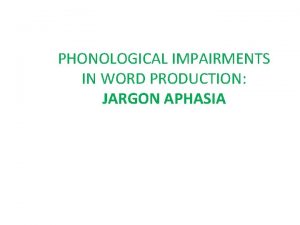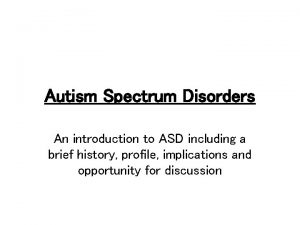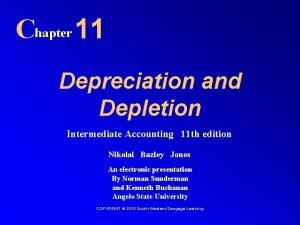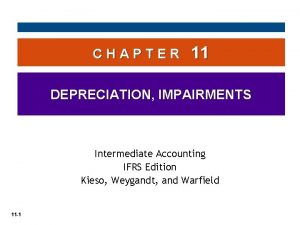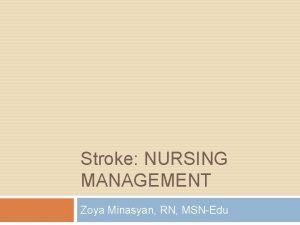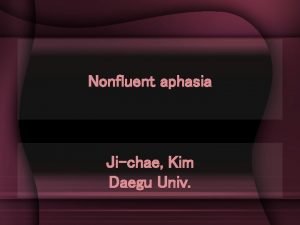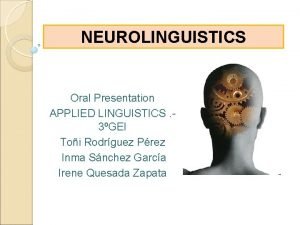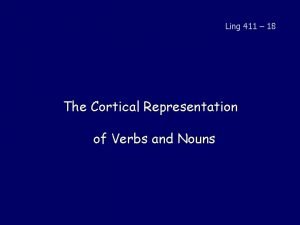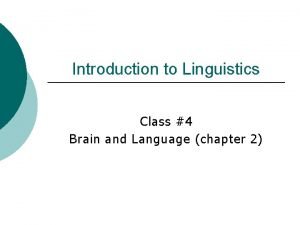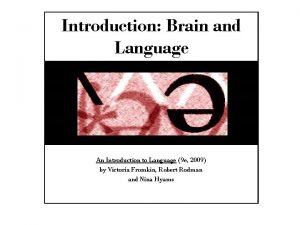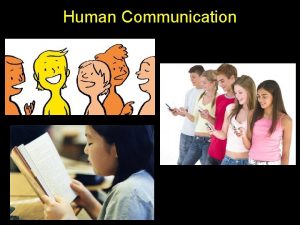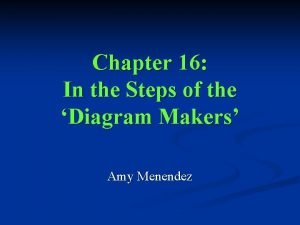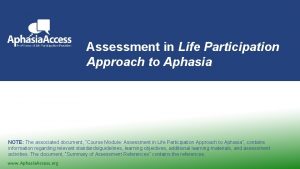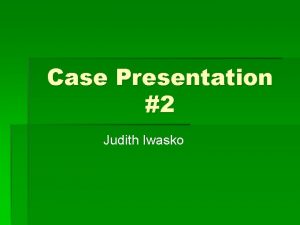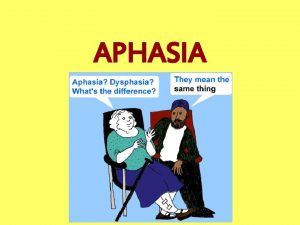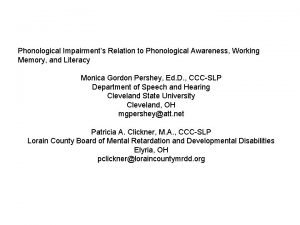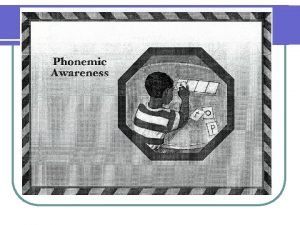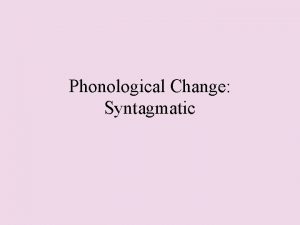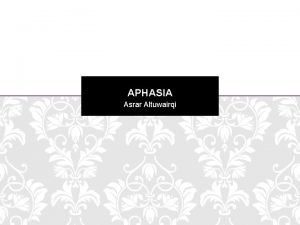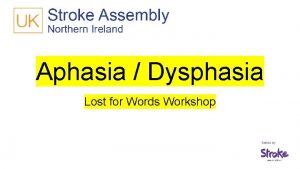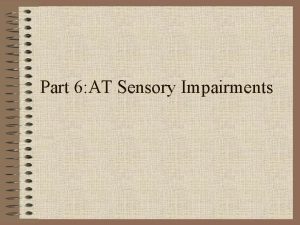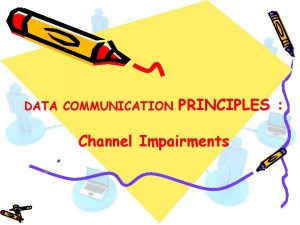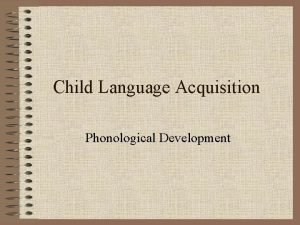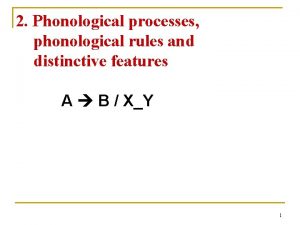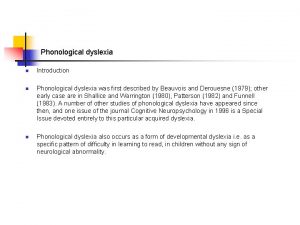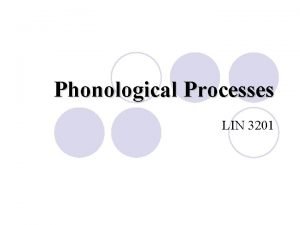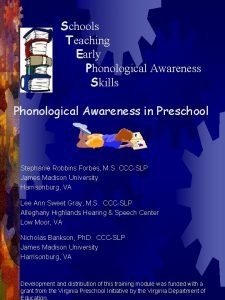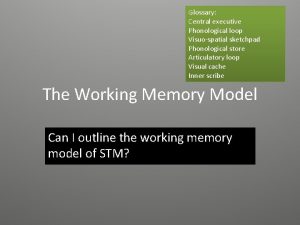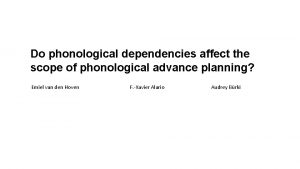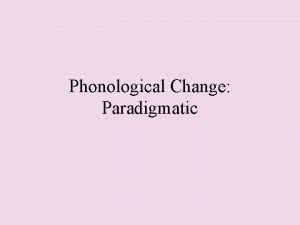PHONOLOGICAL IMPAIRMENTS IN WORD PRODUCTION JARGON APHASIA Jargon





















- Slides: 21

PHONOLOGICAL IMPAIRMENTS IN WORD PRODUCTION: JARGON APHASIA

Jargon aphasia – Fluent speech with a high proportion of phonological errors which bear very little resemblance with the target – generally called neologisms. Phonemic or undifferentiated jargon (with nonsensical words) should be distinguished from semantic jargon composed by real words. In the lecture, we will talk of phonemic jargon.

Characteristics of jargon • Speech is fluent by unintelligible because of high proportion of neologisms • Speech has a clearly discernible syntactic and prosodic structure o Often, grammatical markers (inflections and derivations) and function words are preserved. o Prosodic and phonetic characteristics are also preserved (Hanlon & Edmonson, 1996). Sentences have: Normal length Normal melodic contour (e. g. , normal pitch declination, normal lengthening of final vowels) • There is little evidence of any awareness of the problems or attempt at self correct

Different types of errors in jargonaphasia Terminology Target related neologisms = nonword errors = phonological errors Unrelated phonological errors = abstruse neologisms = neologisms More formal definition for neologisms= less than 50% of phonemes in common with the target, but this does not ensure that there is no relationship Question: Are neologisms intrinsically different from other types of nonword errors? Or are all nonword errors the same, only differing along a continuum of severity?

Example from patient FF (Bose & Buchanan, 2007) Examiner: Tell me about your work FF: I used to drive. . I. . . freda pridyburger. . then I was. . . I did not work anywhere. . i work but prior to that. . was. . . uh. . taeba tigyban. . . pigyburger. . i do not know Picture description: Cookie theft (BDAE). . . like the cold air the water is breaking out of the sink and it’s going under this floor. . . an um. . going up the floor when uh birch go and. . . This kib is goboingbig is going pri on an ank. . . can’t see what this dates got a lot of gigyham and poirb it ig ts but over is yub ya. . She is got her job. . and. . . pigyburger. . . She got dentalated and one pigbigger. . and he pipen. . .

Characteristics of nonword errors • Obey phonotactic constraints - Native phonemes - Legal combinations of phonemes Even in cases of complete jargon (e. g. , Hanlon & Edmonson, 1996) • Generally, phonemes respect the frequency distribution of phonemes in the patient’s language (e. g. , Cohen et al. , 1997; Hanlon & Edmundson, 1996; Robson et al. , 2003, • but in other cases, the distribution is idiosyncratic (e. g. , Perecman & Brown, 1981; Penser & Temp, 1981; Butterworth, 1979 selective for nontarget related errors) • Linked to a tendency to perseverate? Neighbouring nonword errors show similar phonological structures Tendency to use favourite phonemes, or phoneme combinations

Locus of nonword errors POST LEXICAL ACCESS Failures in phoneme selection Failure to access the right phonemes corresponding to a lexical representation Failure at a stage called phonological-lexical because it involves the phonemes of a lexical representation BUT is the locus of all nonword errors the same? Or is it different for different types of nonword errors? Is is the same for neologisms and target-related errors?

Locus of neologisms Two hypotheses 1. The locus of neologisms is THE SAME as that of other nonword errors = failure in selecting phonemes for a word Jargonaphasia like conduction aphasia Evidence: • With recovery >> more related errors >> evidence of a milder impairment (Panzeri et al. , 1987; Simons & Buckingham, 1992) • Errors have similar frequency in naming, repetition and reading (Olson et al. , 2007; Moses et al. , 2004). This is evidence of a post-lexical locus because, if the problem were in lexical access, difficulties should be much more severe in naming.

2. The locus of neologisms is DIFFERENT from that of other nonword errors = failure in selecting the right word (or failure in lexical access)>> errors generated by a RANDOM PHONEME GENERATOR Jargonaphasia like anomia Evidence: • Errors tend to replace content words; but only because they are lower frequency? • Occur more often on lower frequency words; but because these words are both harder to access and harder to phonologically encode? (e. g. , Buckingham & Kertesz, 1976; Butterworth, 1979; Butterworth et al. , 1981; Lecours, 1982; O’Connel, 1981) • Follow longer pauses than target-related errors; but only because the representation is more degraded? • Show different frequency distributions of phonemes; but only because they use more stereotyped filler phonemes? (e. g. , KC: Butterworth, 1979; 1985; Kohn et al. , 1996)

Evidence for a common post-lexical access locus for both neologisms and other target related errors • Target relatedness is present even in apparently abstruse errors o Even when listeners could not derive targets of neologistic errors made in picture naming, formal analyses revealed that neologisms contained more phonemes in common with the target than expected by chance (Robson et al. , 2003). • Errors vary in degree of relatedness to the target along a continuum o There is no bi-polar distribution with one group of errors which are very target related another group which are unrelated. o Instead, relatedness varies, following a normal distribution with no discontinuities (Robson et al. , 2003; Olson et al. , 2007) • Neologisms and target-related errors are affected in the same way by variables such as frequency, immaginability and length (Olson et al. , 2007; 2015).

What can disrupt phoneme selection ? 1. Two types of general damage in the network (Schwartz et al. (1994). : 1. Weakening of connections from word nodes to phoneme nodes - lexical bias is weakened >> nonword errors; 2. Faster decay of activation - Instead, fast decay of lexical activation means reduced feed-back from target words to corresponding phonemes so that phonemes from other words can be selected instead; however, since connections from words to phonemes are preserved the lexical bias is maintained. >> word errors 2. Two types of connection damage (Fygel & Dell, 2000): 1. From lexical representations to phonemes >>nonword errors (also Hillis et al. , 1999) or 2 From semantic to lexical representations >> word errors

BUT what accounts for the SPECIAL characteristics of neologistic errors?

Tendency to perseverate in jargon aphasia • Perseverations occur when part or all of the phonemic content of a previous response are reproduced in later responses; • They are very common in jargon aphasia; • Linked to lack of recovery (e. g. , Kohn et al. , 1996; Goldman et al. , 2001)

Examples of perseverations from KC (Butterworth, 1979): beklend, beniks, audiks, zandiks, lendiks, zaepriks Causes: • Activation of previous representations is too high or fails to decay; • Activation of target representation is too weak to displace old representations in an output buffer. Two types: • Partial perseverations – blended perseverations - Occur at the phoneme level? • criterion 50% of phonemes in common with a previous response (e. g. , Moses, 2004) • Whole word perseveration - total word perseverations - Occur at the lexical level? Reactivation of preactivated lexical nodes?

Alternative: All perseverations arise at the post lexical access, at the phoneme level; They derive from the use of a limited pool of stereotypical phonemes. Evidence: • Whole word and whole-nonword perseverations co-occur. They can be due to the use of the same fill in materials; • Whole word/nonword perseverations which occur across long intervals (with gaps of 4 or more intervening words) can be especially built around default phonology; • Perseveration which occur at closer intervals can be built on pre-existing activation; • Perseverations cannot be explained in terms of semantic relatedness (they do not occur more frequently across words sharing semantic features; e. g. , Eaton et al. , 2010)

• Stereotypical phonemes are over-represented in perseverative compared to non perseverative responses • Stereotypical phonemes are equally used in total word and nonword perseverations

Other special features of jargon aphasia • Over-arousal of the language system (e. g. , Kingsbourne & Warrrington, 1963; Rochford, 1974; Romani et al, 2002 ) Evidence: • Patients over produce speech • Increased N of syllables in errors (O’Connell, 1981) • Failure of activation to decline (Pratter et al. 1997) • Blends between lexical representations (Romani et al. , 2002)

• Difficulties of self monitoring • Patients seem unaware of their deficits • They persist in talking even when they make no sense • They are irritated by other people ‘s failures to understand • Make few attempts at self correct • But unawareness is not complete (e. g. , Graham et al. , 2001)

Explanations of difficulties in self-monitoring • Anosognosia or denial of illness • (e. g. , Prigatano & Weinstein, 1996) • Linked to personality characteristics? BUT Unawareness may be modality specific (e. g. , restricted to spoken or written modality; e. g. , Ihori et al. , 1994; Robson et al. , 1998) • Difficulties in monitoring speech output BUT Not all studies report comprehension impairments in jargon aphasia (e. g. Confront Marshall et al. , 1994 with Nickels & Howard, 1995) Single case studies show lack of monitoring, but intact auditory input skills (e. g. , Dunward et al. , 2000; Marshall et al. , 1998; Robson et al. , 1998)

Alternative explanations • Deficits in a feedback route? • Resource limitations? • Failure in a specific production-based monitoring? • A mechanism possibly associated with covert repairs

After the lecture and the relevant readings you should be able to: • Discuss the possible locus and word errors and nonword errors and evidence for a single common source versus two possible sources • Discuss possible mechanisms for the production of neologistic errors compared to other nonword errors • Discuss difficulties of self-monitoring as a possible cause of neologistic errors.
 Phonemic jargon
Phonemic jargon Post production
Post production Wings triad
Wings triad Depletion
Depletion Composite depreciation rate
Composite depreciation rate Modifiers of human acts examples
Modifiers of human acts examples Chapter 11 depreciation impairments and depletion
Chapter 11 depreciation impairments and depletion Broca's aphasia example
Broca's aphasia example Nursing intervention for aphasia
Nursing intervention for aphasia Aphasia means
Aphasia means Transcortical motor aphasia
Transcortical motor aphasia Conduction aphasia
Conduction aphasia Examples of aphasia
Examples of aphasia Broca’s area function
Broca’s area function Examples of aphasia
Examples of aphasia Conduction aphasia
Conduction aphasia Aphasia definition
Aphasia definition Pico question examples aphasia
Pico question examples aphasia Pyramidal tracts
Pyramidal tracts Asha qcl
Asha qcl Aphasia pathfinder
Aphasia pathfinder Language
Language
